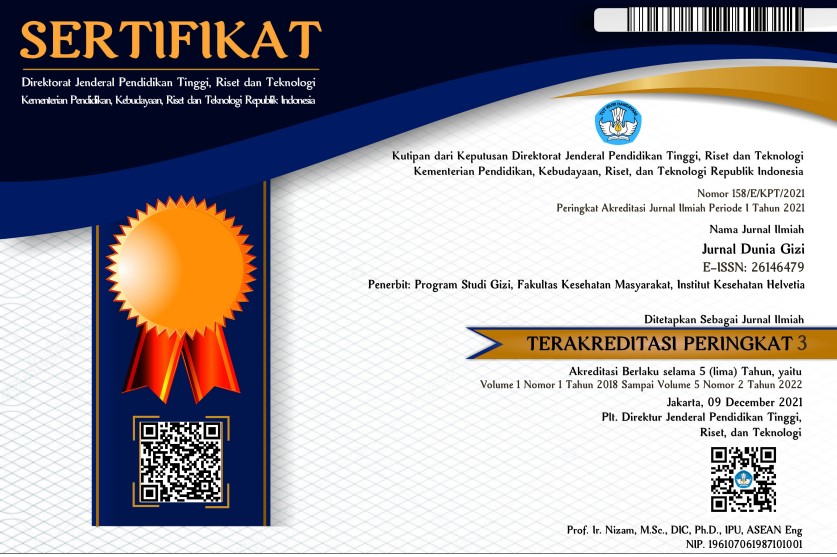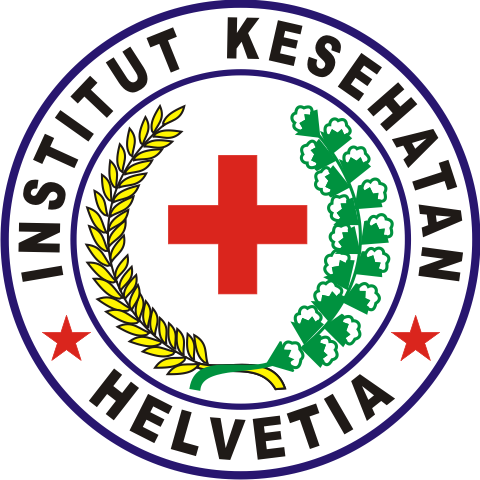Difference of Socio-Economic Characteristics based on Food Security Levels in Urban and Rural Poor Household in South Sulawesi
Abstract
Backgorund; Nutritional problems arise due to the problem of food security at the household level, namely the ability of households to obtain food for all household members. This reflects the lack of accessibility of households to obtain food, one of which is caused by poverty. Many factors can affect household food security. Aim; This study aims to analyze differences in socio-economic characteristics based on the level of food security of poor urban and rural households in South Sulawesi as measured by the HFIAS Method and the modified Maxwell Method. Method; This study used a cross sectional design. Sampling using purposive sampling with a sample size of 170 households. Data analysis performed was bivariate analysis with t-independent test and chi square test. Results; The results showed that the variables that had differences between food-security and food-insecurity household groups as measured by the HFIAS method were household size (p = 0,000), while variables that had differences between household groups were food-security and food-insecurity (0.029) and household size (p = 0.000). Conclusions; Household size variables have differences between food-security and food-insecurity household groups as measured by the HFIAS method and the modified Maxwell method. Household size is an important variable that affects the level of household food security.
Keywords
Full Text:
PDFReferences
Supariasa IDN, Bakri B, Fajar I. Penilaian Status Gizi. Jakarta: EGC; 2012.
Suhardjo. Pengertian dan Kerangka Pikir Ketahanan Pangan Rumah Tangga. Bogor: PSKPG, LP. Institut Pertanian Bogor; 1994.
Kementerian Pertanian, World Food Programme. Peta Ketahanan dan Kerentanan Pangan Indonesia. Jakarta: Dewan Ketahanan Pangan; 2015.
Badan Pusat Statistik. Indikator Kesejahteraan Rakyat. Jakarta; 2015.
Badan Pusat Statistik. Indikator Kesejahteraan Rakyat. Jakarta; 2018.
Lantarsih R, Widodo S, Darwanto DH, Lestari SB, Paramita S. Sistem Ketahanan Pangan Nasional: Kontribusi ketersediaan dan konsumsi energi serta optimalisasi distrubusi Beras. Anal Kebijak Pertan. 2011;9(1):33–51.
Sari AK, Andrias DR. Faktor sosial ekonomi yang berhubungan dengan ketahanan pangan rumah tangga nelayan perkotaan di Surabaya. Media Gizi Indones. 2013;9(1):54–9.
Purwantini TB, Rachman HPS, Marisa Y. Analisis ketahanan pangan tingkat rumah tangga dan regional ( Studi Kasus di Provinsi Sulawesi Utara ). Buletin Agro Ekonomi. 2002;
Badan Pusat Statistik. Laporan Bulanan Data Sosial Ekonomi Provinsi Sulawesi Selatan September 2018. Makassar; 2018.
Badan Pusat Statistik Makassar. Kota Makassar Dalam Angka 2018. Makassar; 2018.
BPS Sidenreng Rappang. Kabupaten Sidenreng Rappang dalam Angka 2018. Sidenreng Rappang: BPS Sidenreng Rappang; 2018.
Swindale A, Bilinsky P. Development of a universally applicable household food insecurity measurement tool: process, current status, and outstanding issues. Nutr. 2006;136(5):1449–952.
Coates J, Frongillo E., Rogers B., Webb P, Wilde P., Houser R. Commonalities in the experience of household food insecurity across cultures: what are measures missing. Nutr. 2006;136(5):1438–48.
Coates J, Swindale A, Bilinsky P. Household Food Insecurity Access Scale (HFIAS) for Measurement of Food Access: Indicator Guide. Wahington DC: Food and Nutrition Technical Assistance Project. Academy for Educational Development; 2007.
Salarkia N, Abdollahi M, Amini M. An a adapted household food insecurity access scale is a valid tool as a proxy measure of food access for use in urban Iran. Food Sec. 2014;6(275-):275–82.
Jonsson U, Toole D. Household Food Security and Nutrition: A Conceptual Analysis. 1991;
Maxwell D, Levin C, Armar-klemesu M, Ruel M, Morris S, Ahiadeke C. Urban livelihoods and food and nutrition security in greater accra, ghana. 2000;(APRIL).
A OO. Assessment of Households’ Food Access and Food Insecurity inUrban Nigeria: A Case Study of Lagos Metropolis. 2014;14(1).
Yuliana P, Zakaria WA AR. Ketahanan pangan rumah tangga nelayan di Kecamatan Teluk Betung Selatan Kota Bandar Lampung. JIIA. 2013;1(2):181–6.
Fry HH, Azad K, Kuddus A, Shaha S, Nahar B, Hossen M, Younes L, Costello A FE. Socio-economic determinants of household food security and women’s dietary diversity in rural Bangladesh: a cross-sectional study. J Heal Popul Nutr. 2015;33(2).
January I. Tingkat ketahanan pangan rumah tangga petani dan pengaruh kebijakan raskin. J Ekon Pembang. 2014;15(2):109–16.
Mutisya M, Ngware MW, Kabiru CW. The effect of education on household food security in two informal urban settlements in Kenya : a longitudinal analysis. Food Secur. 2016;8:743–56.
Markwick A, Ansari Z, Sullivan M MJ. Social determinants and lifestyle risk factors only partially explain the higher prevalence of food insecurity among Aboriginal and Torres Strait Islanders in the Australian state of Victoria: a cross-sectional study. BMC Public Health. 2014;14(598).
Knueppel D, Demment M KL. Validation of the household food insecurity access scale in rural Tanzania. Pub Heal Nutr. 2010;13(3):360–7.
Tanziha I HE. Analisis jalur faktor-faktor yang memengaruhi ketahanan pangan rumah tangga di Kabupaten Lebak, Provinsi Banten. J Giz Pang. 2009;4(2):107–16.
Arida A, Sofyan FK. Analisis ketahanan pangan rumah tangga berdasarkan proporsi pengeluaran pangan dan konsumsi energi. Agrisep 2015; 16(1): 20-34. 2015;16(1):20–34.
Lindawati, Saptanto S. Analysis of Poverty Level and Food Security Based on Consumption Expenditure Level in The Fish Farmer Household ( Case Study in Sumur Gintung Village , Subang District , West Java ). J Sosek KP. 2014;9(2):195–206.
Olayemi AO. Effects of family size on household food security in Osun State, Nigeria. Asian J Agr Rural Dev. 2012;2(2):136–41.
Sari MR, Prishardoyo. Faktor-faktor yang memengaruhi kerawanan pangan rumah tangga miskin di Desa Wiru Kecamatan Bringin Kabupaten Semarang. JEJAK. 2009;2(2):135–43.
Hardinsyah. Review faktor determinan keragaman konsumsi pangan. J Giz Pangan. 2007;2(2):55–77.
Taruvinga A, Muchenje V MA. Determinants of rural household dietary diversity: the case of Amatole and Nyandeni district, South Africa. Int J Dev Sustain. 2013;2(3):1–15.
Tefera T TF. Determinants of households food security and coping strategies for food shortfall in mareko district, guraghe zone southern Ethiopia. J Food Secur. 2014;2(3):92–9.
Sukiyono K, Cahyadinata I S. Status Wanita dan Ketahanan Pangan Rumah tangga Nelayan dan Petani Padi di Kabupaten Muko-Muko Provinsi Bengkulu. J Agro Ekon. 2008;26(2):197–207.
Rahman MA, Abka R, Rahman MS, Sarma PK. Poverty and food security analysis : A study of fishermen households in a selected area of Bangladesh. J Bangladesh Agril. 2013;11(2):293–9.
Soekirman. Ilmu Gizi dan Aplikasinya. Direktorat Jenderal Pendidikan Tinggi Departemen Pendidikan Nasional, editor. Jakarta; 2000. 641 p.
Susilowati H, Purnastuti L. Faktor-faktor yang mempengaruhi ketahanan pangan rumah tangga miskin di kecamatan srandakan bantul. JPE. 2014;4(`1).
Bilinsky P, Swindale A. Validation Household Dietary Diversity Score (HDDS) to identify food insecure household in industrial area. Pak J Nutr. 2015;14(4):234–8.
DOI: https://doi.org/10.33085/jdg.v2i1.4339
Refbacks
- There are currently no refbacks.

This work is licensed under a Creative Commons Attribution-NonCommercial 4.0 International License.









1.png)







.png)










